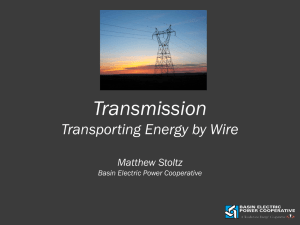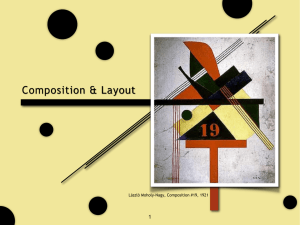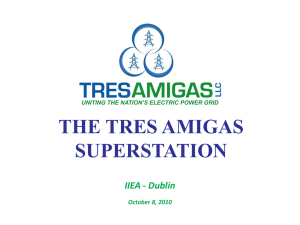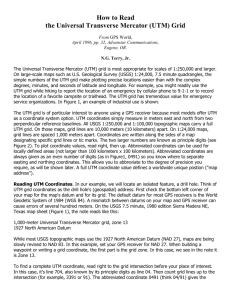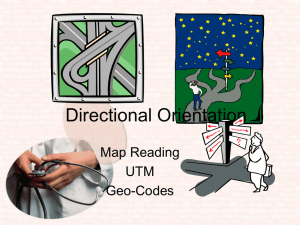Projections and Coordinates
advertisement
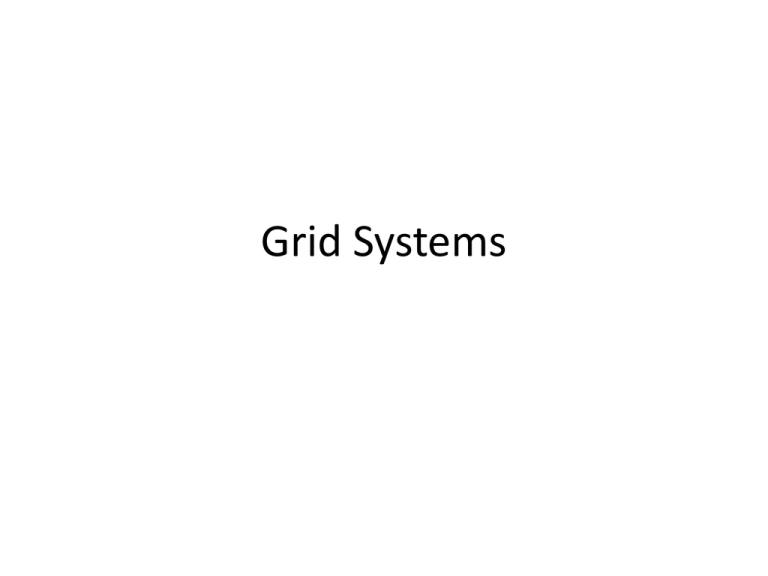
Grid Systems Transverse Mercator Projection Universal Transverse Mercator South Dakota Zone 16 • Based on Transverse Mercator (cylindrical) projection • World divided into 60 zones 6 degrees wide • Distortion is minimal within each zone • Maps of different areas use best zone Copyright © 2009for by Maribeth • Best maps covering small3-3area in one zone H. Price UTM Zones UTM Pole to Pole Halfway to the Pole Using UTM Using UTM Using UTM Three Kinds of North • True North – Along Meridians • Magnetic North – What a compass detects – Important in field – Not important in most GIS • Grid North – Along N-S grid lines – Minor importance for compass work – Be aware there’s a difference! – Military uses exclusively Cautions About UTM • Military maps use two letter codes for each 100-km square, but maps will have information to enable conventional UTM • With military grid references, number of digits indicates level of precision • Older maps will sometimes have obsolete grids • Datum, datum, datum! Military Grid System • • • • • • 45N 89 W = E 342,369, N 4,984,896 Zone 16T Digraph = CQ 1 km accuracy = 16T CQ 42 84 100 m accuracy = 16T CQ 423 848 10 m accuracy = 16T CQ 4236 8489 1 m accuracy = 16T CQ 42369 84896 • Ticks on USGS topo map = 342,000, 4,984,000 Where Zones Meet Why a Grid? Latitude /Longitude Grid System North varies from place to place on the map Grid north is always the same direction Angular units differ in scale between N-S and E-W Grid scale the same in all directions E-W angular units vary in scale with latitude Grid squares are always the same size and shape Hexadecimal Scale Decimal Scale State Plane System • States divided into one or more zones identified by a unique FIPS number • Uses several types of projections • E-W zones generally Conic, N-S zones generally UTM Copyright © 2009 by Maribeth H. Price 3-15 Projections for large scale maps • Local, city, county maps, smaller states – Projection systems virtually eliminate distortion – Choose appropriate UTM or State Plane zone Copyright © 2009 by Maribeth H. Price 3-16 Wisconsin State Plane Zones Wisconsin Grid Systems Projections for smaller scales • Distortion is inevitable, so purpose drives the choice – Equidistant maps when distances are important – Equal area maps when areas are important – Conformal or compromise projections for general purpose maps Copyright © 2009 by Maribeth H. Price Coordinate system names generally indicate the locale and purpose it is optimized for. Use for clues to choice. 3-19 Metes and Bounds System Public Land Survey System • AKA Congressional System • Established 1785 • Does not apply to: – 13 Original Colonies – Derivative States (VT, KY, TN, ME, WV) – Texas (Former independent country) – Hawaii (Uses Kingdom of Hawaii system) • Land Division – 6 x 6 mile townships, 36 sections, quarter sections USA Public Land Surveys NonCongressional Grids Before Greenwich Arbitrary Geography More Arbitrary Geography Grid vs. No Grid Gridded Landscape Where Wisconsin’s Grid Starts Where California’s Grid Starts Section Numbering Wisconsin Townships Township Labels Section Descriptions Limitations of the Congressional Land Survey System Congressional Land Survey System • Not an accurate grid! • Locations within subdivisions may be imprecise • Data points used in GIS may be tied to system • Authoritative surveys are forever – French strips in LA, MO, WI – Spanish and Mexican land grants French Long Lot System French Long Lot System California: PLSS and Land Grants California: PLSS and Land Grants Oh, Canada • Eastern Canada: Metes and Bounds, Long Lot • Northern Ontario: 6 and 10-mile townships • Western Canada: Dominion Land Survey – – – – – – – Modeled on PLSS 6-mile townships Townships numbered N-S with Arabic numerals Ranges numbered E-W with Arabic or Roman numerals Road allowances between sections Sections zigzag from 1 in SE to 36 in NE (Opposite US) ¼-1/4 sections numbered from 1 in SE to 16 in NE Dangers of Cheap Work Missed It By That Much




